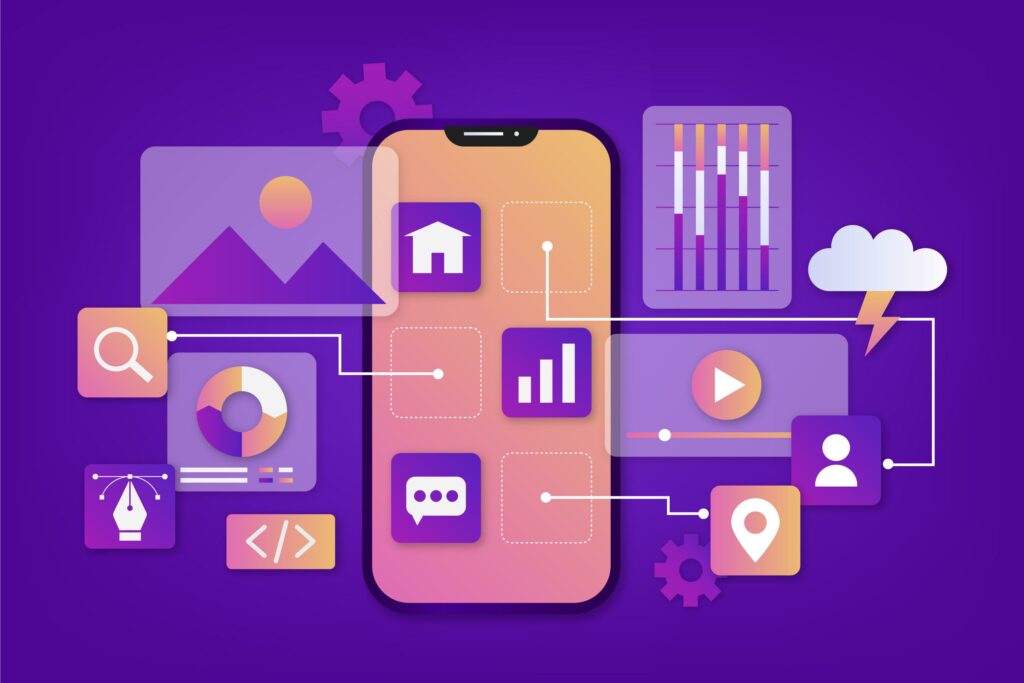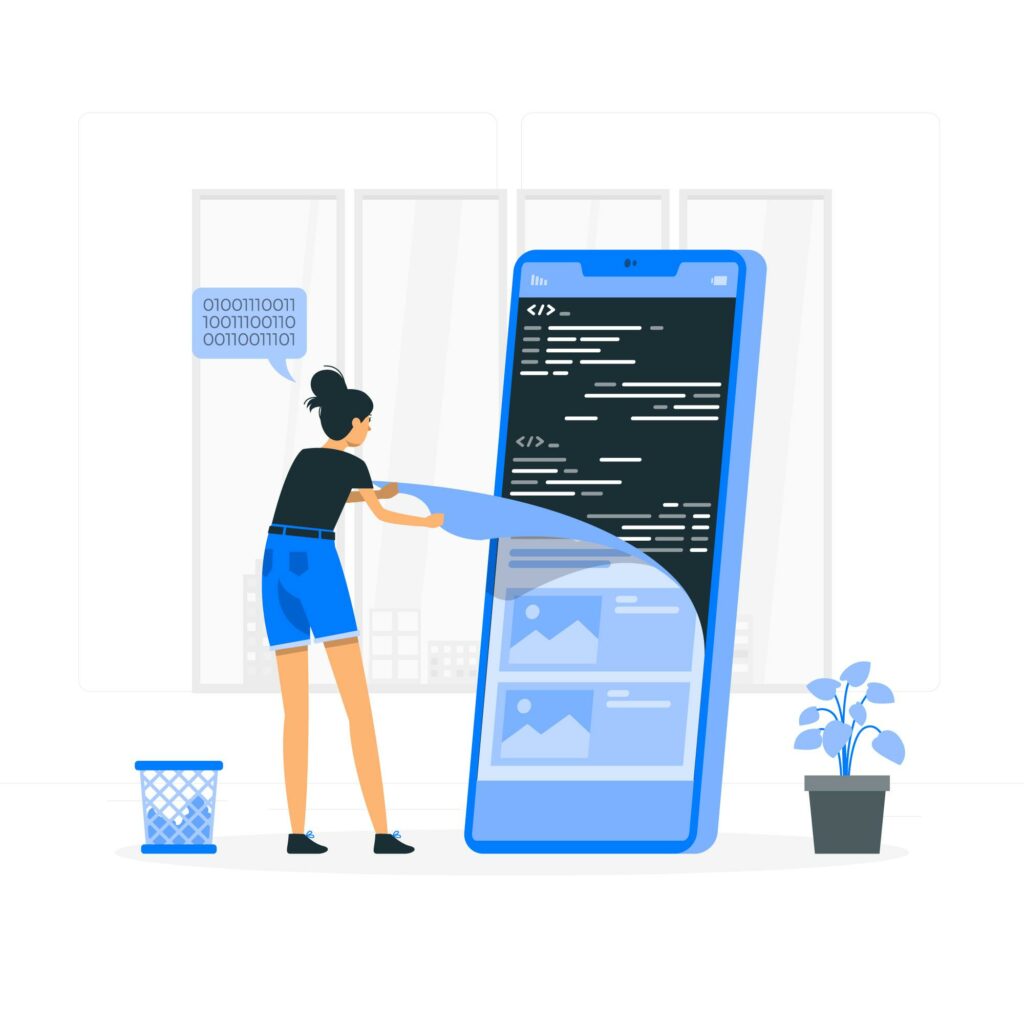Understanding Hybrid Mobile App Development

Hybrid mobile app development represents a contemporary strategy that combines aspects of both native and web applications to create adaptable mobile apps. This approach enables developers to create applications that operate on multiple platforms, such as iOS and Android, using a single codebase. By adopting this method, businesses can optimize their development processes, lower expenses, and improve user engagement across different devices.
What is a Hybrid Mobile App?
A hybrid mobile app can be described as a web application that is encapsulated within a native shell. In essence, while the app’s core is built using web technologies like HTML, CSS, and JavaScript, it is housed within a native application framework. This allows the app to be installed on mobile devices and distributed via app stores.
Key Features of Hybrid Apps:
Single Codebase: Developers can write the code once and deploy it across multiple platforms, which significantly cuts down on development time and costs. This efficiency allows teams to concentrate on enhancing features instead of duplicating efforts for different platforms.
Native Shell: The web application operates within a native container (often utilizing WebView), granting access to device features such as GPS and camera through plugins. This integration allows hybrid apps to leverage functionalities typically reserved for native applications, offering users a more enriched experience.
Cross-Platform Compatibility: Hybrid apps can run on various operating systems without the need for separate codebases for each one. This capability is essential in today’s diverse mobile environment, where users might interact with applications on different devices with varying operating systems.
Architecture of Hybrid Mobile Apps

Hybrid mobile apps generally adhere to a well-defined architecture comprising several layers:
Presentation Layer
This layer encompasses all processes and components that present the app to users. It emphasizes user interface (UI) design and user experience (UX), ensuring that the app is visually attractive and easy to navigate. A thoughtfully designed presentation layer can significantly boost user engagement and satisfaction.
Business Logic Layer
This layer oversees the app’s core functionalities, including data processing and business rules. It ensures that the application functions as intended, managing tasks such as data validation, user authentication, and interactions with external services.
Data Layer
The data layer is responsible for data storage and retrieval. It connects to databases or web services to handle data effectively. A strong data layer is crucial for maintaining data integrity and facilitating smooth interactions between the app and external data sources.
This architectural framework enables hybrid apps to operate reliably, even in situations with limited internet connectivity, while mimicking the look and feel of native applications. Additionally, it supports scalability and enhances maintainability over time.
How Hybrid Apps Work

Hybrid apps utilize web technologies to deliver a smooth user experience while still accessing native device features. Here’s an overview of how they function:
Core Development: The primary application logic is created using HTML, CSS, and JavaScript, which are essential web technologies.
Encapsulation in Native Shell: This web-based core is encapsulated within a native application shell, allowing it to be installed on devices like any standard native app.
Use of Frameworks: Frameworks such as React Native, Ionic, and Flutter offer tools and libraries that facilitate the development of hybrid applications by providing native-like UI components.
Accessing Device Features: Hybrid apps can access device functionalities like notifications, camera, and location services through APIs and plugins. This capability enhances usability without compromising performance.
Overall, hybrid apps combine the advantages of both web and native applications, allowing for efficient development and a rich user experience across various platforms.
Advantages of Hybrid Mobile App Development

Hybrid app development provides a variety of advantages:
Cost-Effectiveness: Creating a single codebase for multiple platforms significantly lowers costs compared to developing separate native apps for iOS and Android. This financial efficiency allows companies to better allocate resources towards marketing or feature enhancements.
Faster Development Time: With a unified codebase, businesses can achieve quicker iterations and updates, allowing them to launch products more rapidly. This speed is crucial in competitive markets where being the first to market can offer a substantial edge.
Simplified Maintenance: Maintaining one codebase simplifies the process of implementing updates and fixing bugs across platforms. Developers can make changes once instead of managing multiple app versions, which reduces the likelihood of errors.
Wider Reach: Hybrid apps enable businesses to target users on various operating systems simultaneously, maximizing audience reach. This broad accessibility can lead to increased user engagement and higher download rates.
Access to Device Features: Through plugins, hybrid apps can utilize native device functionalities such as push notifications, camera access, and geolocation services. This capability enhances the overall user experience by integrating essential features directly into the app.
Overall, hybrid mobile app development offers an efficient solution that balances cost, speed, and functionality while ensuring a consistent user experience across different platforms.
Challenges of Hybrid Mobile App Development

While hybrid app development has its advantages, it also comes with several challenges:
Performance Issues: Hybrid apps often face performance limitations compared to native apps due to the extra layer between the code and device hardware. This can lead to slower load times and less responsive user interfaces, making performance optimization essential for a smooth user experience.
User Experience Variability: The user experience may vary across different platforms if not designed carefully, potentially resulting in inconsistencies in functionality or appearance. Developers need to adhere closely to platform-specific design guidelines to maintain uniformity.
Dependency on Third-Party Plugins: Accessing native functionalities typically relies on third-party plugins, which may not always be reliable or updated. If these plugins become deprecated or unsupported, it can result in significant issues affecting app functionality.
Overall, these challenges necessitate careful planning and execution in hybrid app development to ensure that the final product meets user expectations and performs effectively across various platforms.
Popular Hybrid Mobile App Development Frameworks

Several frameworks have emerged as leaders in the realm of hybrid mobile app development:
React Native: Developed by Facebook, React Native allows developers to create applications that are rendered natively using React. It provides components that render as native views, ensuring high performance and a native-like experience while enabling developers to utilize familiar JavaScript syntax.
Ionic: Ionic is a widely adopted open-source framework that empowers developers to build hybrid apps using web technologies. It features a comprehensive library of UI components that replicate native interfaces, simplifying the creation of visually appealing applications.
Flutter: Created by Google, Flutter utilizes the Dart programming language and is known for its rapid development cycles, including hot reload capabilities. It offers an expressive UI and high performance across platforms, enabling developers to quickly craft beautiful applications.
Apache Cordova: Apache Cordova allows developers to use standard web technologies while providing access to device capabilities through plugins. This framework facilitates the seamless integration of native features into web-based applications.
These frameworks each bring unique strengths to hybrid mobile app development, making it easier for developers to create efficient, high-quality applications that work across multiple platforms.
Best Practices for Hybrid App Development

To achieve successful hybrid app development, consider the following best practices:
Define Your Requirements: Before starting development, clearly understand your target audience, desired features, performance expectations, and scalability needs. This foundational step guides architectural decisions throughout the project lifecycle.
Design for Responsiveness: Utilize responsive UI frameworks such as Bootstrap or Foundation to ensure that your app adapts seamlessly across devices. Designing for responsiveness guarantees an optimal experience for users, regardless of screen size or resolution.
Implement Modular Architecture: Break down the application into reusable components to enhance maintainability. A modular architecture promotes code reusability and simplifies updates, allowing developers to modify individual components without impacting the entire application.
Optimize Performance: Focus on minimizing loading times and enhancing responsiveness by reducing unnecessary requests and utilizing caching techniques. Performance optimization is crucial for delivering a smooth user experience.
Prioritize Security: Implement secure coding practices, data encryption, and regular security testing to safeguard user data and prevent vulnerabilities. Prioritizing security is essential to maintain user trust and protect sensitive information.
By adhering to these best practices, businesses can ensure that their hybrid apps are efficient, user-friendly, and capable of delivering a high-quality experience across various devices and platforms.
Choosing Between Hybrid and Native Development

The decision to choose between hybrid and native mobile app development ultimately depends on the specific requirements of your project. Here are some factors to consider when making this choice:
1. Performance Needs: If the app requires extensive processing power, graphics-heavy features, or real-time interactions, native development may be more suitable due to its superior performance. Native apps can better leverage device hardware and provide smoother animations and responses.
2. Development Budget: Hybrid development is generally more cost-effective, especially for businesses aiming to launch on multiple platforms. A single codebase across iOS and Android saves both time and resources, making it an ideal choice for startups or smaller businesses.
3. Time Constraints: Hybrid development is faster because it enables developers to write one codebase for both platforms. If you need to get your app to market quickly, hybrid development may be a more strategic choice.
4. User Experience: Native development provides a better UX for platform-specific apps, as it aligns more closely with the design guidelines and unique features of each operating system. Hybrid apps may fall short in replicating the seamless experience of native apps but can still achieve a high-quality UX with careful design.
5. Long-Term Maintenance: Hybrid apps are easier to maintain as updates are only needed in a single codebase. However, if your app relies heavily on platform-specific functionalities, native development may reduce dependency on third-party plugins and be more reliable long-term.
The choice between hybrid and native development should be based on your app’s performance requirements, budget, and the importance of user experience to your business goals.
Real-World Examples of Hybrid Mobile Apps
Hybrid apps are used by many successful companies to reach wide audiences. Here are a few popular examples:
1. Instagram: The popular social media app utilizes a hybrid model to ensure a consistent experience for users on both Android and iOS. This approach has helped Instagram scale rapidly and provide updates efficiently across platforms.
2. Uber: As a ride-sharing platform that requires reliable performance across different devices and operating systems, Uber chose hybrid development to facilitate fast, uniform updates while ensuring a seamless experience for users.
3. Twitter: Twitter’s hybrid app allows users to experience similar functionality and features on both iOS and Android, providing a streamlined user experience across platforms while simplifying development efforts.
4. LinkedIn: The professional networking app opted for a hybrid approach to reach its global user base, making it easier to deploy updates while maintaining a familiar interface for all users.
Future Trends in Hybrid Mobile App Development

Hybrid mobile app development is constantly evolving with emerging technologies. Here are some trends to watch in this field:
1. Progressive Web Apps (PWAs): PWAs combine the best of web and mobile apps, offering faster load times, offline access, and a native app feel without needing app stores. As PWA capabilities grow, they may increasingly overlap with hybrid app functionalities.
2. AI and Machine Learning Integration: Hybrid apps are beginning to incorporate AI and machine learning for features like personalized recommendations, image recognition, and voice commands, enhancing user experiences.
3. Enhanced Tooling and Frameworks: Frameworks like Flutter and React Native are continually advancing, offering more pre-built components and better performance. These improvements make hybrid app development more competitive with native apps.
4. Focus on Security: As more businesses handle sensitive data through hybrid apps, security will remain a top priority. Enhanced encryption methods, data protection protocols, and stricter privacy practices will become integral to hybrid app development.
5. Internet of Things (IoT) Compatibility: With the rise of IoT, hybrid apps are increasingly being used to control and interact with IoT devices. This trend will likely lead to more integrations and specialized features for connected devices.
These trends highlight the dynamic nature of hybrid app development and underscore the technology’s potential to adapt to the changing digital landscape.
[Want to learn more about hybrid mobile app development? Click here to reach us.]
Conclusion
Hybrid mobile app development combines native and web technologies to create cross-platform apps, offering cost savings, faster development, and broader reach—ideal for businesses seeking efficient entry into the mobile market. While challenges exist, they are manageable with careful planning, the right frameworks, and best practices.
At Bobcares, we specialize in hybrid app development, delivering high-quality, cross-platform solutions that perform seamlessly across devices. Our expertise ensures an engaging, consistent user experience, helping businesses of all sizes succeed in the mobile landscape with efficient and reliable hybrid app development solutions.







0 Comments